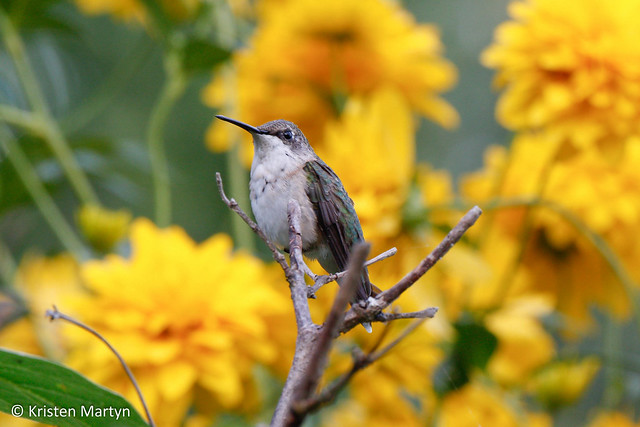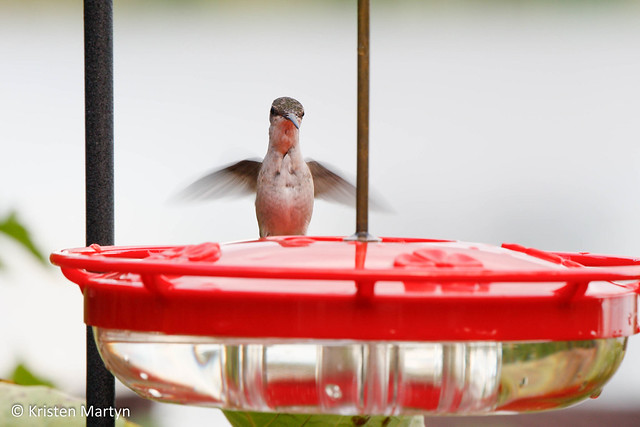Getting to Know the Ruby-throated Hummingbird
'Tis the season, the Ruby-throated Hummingbirds are returning to Simcoe County for another summer. Have you seen any of these little flying jewels yet? Keep your eyes peeled and your feeders full to ensure they see your yard as the perfect place to settle down and make a home so you can enjoy them all summer long. Want to know more about these remarkable little birds? Read on!
Did you know there are over 18 different hummingbird species in North America (and over 325 species total)? The Ruby-throated Hummingbird is the only breeding species here in Simcoe County, but occasionally a wayward Rufus does make an appearance for us to enjoy. Hummingbirds are the second largest bird family (only flycatchers have more) and are only found in the New World (North, Central and South America).
While here in Simcoe County, Ruby-throated Hummingbirds can be found in deciduous woodlands; commonly associated
with old fields, forest edges, meadows, orchards, stream borders, and
of course, backyards. When in their tropical wintering grounds, they live in dry forests, citrus groves, hedgerows, and scrub.
Ruby-throated Hummingbirds feed on the nectar of red, orange and purple tubular
flowers such as Obedient Plant, Wild Columbine and Wild Bergamot (also known as bee-balm). While Hummingbirds are not born with an innate preference for the colour red, they do quickly learn to associate certain flower colours with food. They also eat insects and insect eggs on the ground, plucked from spider webs, and in trees. They love spiders and spider eggs, and use their bill and not their tongue to catch insects. Contrary to popular belief, they do not suck up the nectar through their bill, instead they lap up nectar with their long, grooved tongues. These grooves on
either side of the tongue create a capillary action helping draw
the nectar up the tongue and into the mouth. They can move their tongues in and out of their bill up to 12 times a second while eating!
Hummingbirds eat about every ten minutes. You can feed Hummingbirds in your backyard by planting tubular flowers and/or hanging feeders filled with a nectar solution. This solution is super easy to make at home: Mix
four parts water and one part ordinary table sugar to create the
perfect nectar solution. Example: (4 cups of water, 1 cup of sugar). Be sure to change the nectar and wash your feeder in hot water every three to
four days (more often in hot weather or if you see it turning cloudy). If you have a WBU Hummingbird Feeder, you can simply place it in the top rack of your dishwasher. To save time, you can to make a large batch ahead of time and store the leftover solution in the fridge. Just be sure to boil the water first before mixing in the sugar. Never add red food coloring, honey or artificial sweeteners to the solution, as this can harm the birds and is unnecessary. Place the feeder(s) near your house or by a window for the perfect viewing spot, these birds are very bold and this won't deter them from visiting your feeder(s).
Once laid, the tiny white eggs are incubated for 12-14 days with the nearly-naked nestlings staying in the nest for a further 18-22 days before fledging. Quite often they start a second brood as soon as the first have fledged, each clutch bearing 1-2 eggs.
 |
| Juvenile Ruby-throated Hummingbird in Nest © Wild Birds Unlimited |
Nesting
Hummingbirds start to nest in our region in late May into early June. They build their tiny, thimble sized nests on the top of slender branches. They've also been known to build their nests on clotheslines, loops of chain or other man-made surfaces. The nest site is placed 10-40' above ground and usually in a deciduous tree (such as an oak, poplar or birch). It is constructed of thistle or dandelion and held together with spider silk, allowing the nest to grow in size along with the rapidly growing young.Once laid, the tiny white eggs are incubated for 12-14 days with the nearly-naked nestlings staying in the nest for a further 18-22 days before fledging. Quite often they start a second brood as soon as the first have fledged, each clutch bearing 1-2 eggs.
 |
| Female Ruby-throated Hummingbird © Kristen Martyn |
Cool Facts
- Hummingbirds can extend their tongue almost as long as their bill.
- Hummingbirds can drink up to twice their body weight in nectar every day.
- A mother hummingbird weighs only about eight times more than her egg.
- Hummingbirds have such poorly developed legs that they are unable to walk, instead they can only shuffle along a perch.
- The oldest known Hummingbird was a female, and was at least 9 years, 1 month old when she was recaptured/released during banding operations in West Virginia.
Happy Birding ~Jen


















No comments:
Post a Comment